Aufsatz

Interleaved Learning in Elementary School Mathematics: Effects on the Flexible and Adaptive Use of Subtraction Strategies
Abstract
Empirical findings show that students are often not capable of using number-based strategies and the standard written algorithm flexibly and adaptively to solve multi-digit subtraction problems. Previous studies have pointed out that students predominantly use the standard written algorithm after its introduction, regardless of task characteristics. Interleaved practice seems to be a promising approach to foster the flexible and adaptive use of strategies. In comparison to the usual blocked approach, in which strategies are introduced and practiced successively, they are presented intermixed in interleaved learning. Thus, the students have to choose an appropriate strategy on the basis of every task itself, and this leads to drawing comparisons between the different strategies. Previous research has shown inconsistent results regarding the effectivity of interleaving mathematical tasks. However, according to the attentional bias framework, interleaved practice seems to be a promising approach for teaching subtraction strategies to enhance the students’ flexibility and adaptivity. In this study, 236 German third graders were randomly assigned to either an interleaved or blocked condition. In the interleaved condition the comparison processes were supported by prompting the students to compare the strategies (between-comparison), while the students of the blocked approach were encouraged to reflect the adaptivity of a specific strategy for specific subtraction tasks (within-comparison). Both groups were taught to use different number-based strategies (i.e., shortcut strategies and decomposition strategies) and the standard written algorithm for solving three-digit subtraction problems spanning a teaching unit of 14 lessons. The results show that the students of the interleaved condition used the shortcut strategies more frequently than those of the blocked condition, while the students of the interleaved condition applied the decomposition strategies as well as the standard written algorithm less frequently. Furthermore, the students of the interleaved condition had a higher competence in the adaptive use of the shortcut strategies and the standard written algorithm. A subsequent cluster analysis revealed four groups differing in their degree of adaptivity. Being part of clusters with a comparatively high level of adaptivity was positively related to the prior arithmetical achievement and, even more so, to the interleaved teaching approach.
Citation
In: Frontiers in psychology 10 (2019-02-14) , S. 86 ; ISSN: 1664-1078Sponsorship
Gefördert durch den Publikationsfonds der Universität KasselCitation
@article{doi:10.17170/kobra-20190521499,
author={Nemeth, Lea and Werker, Katharina and Arend, Julia and Vogel, Sebastian and Lipowsky, Frank},
title={Interleaved Learning in Elementary School Mathematics: Effects on the Flexible and Adaptive Use of Subtraction Strategies},
journal={Frontiers in psychology},
year={2019}
}
0500 Oax 0501 Text $btxt$2rdacontent 0502 Computermedien $bc$2rdacarrier 1100 2019$n2019 1500 1/eng 2050 ##0##http://hdl.handle.net/123456789/11235 3000 Nemeth, Lea 3010 Werker, Katharina 3010 Arend, Julia 3010 Vogel, Sebastian 3010 Lipowsky, Frank 4000 Interleaved Learning in Elementary School Mathematics: Effects on the Flexible and Adaptive Use of Subtraction Strategies / Nemeth, Lea 4030 4060 Online-Ressource 4085 ##0##=u http://nbn-resolving.de/http://hdl.handle.net/123456789/11235=x R 4204 \$dAufsatz 4170 7136 ##0##http://hdl.handle.net/123456789/11235
<resource xsi:schemaLocation="http://datacite.org/schema/kernel-2.2 http://schema.datacite.org/meta/kernel-2.2/metadata.xsd"> 2019-05-21T12:01:10Z 2019-05-21T12:01:10Z 2019-02-14 doi:10.17170/kobra-20190521499 http://hdl.handle.net/123456789/11235 Gefördert durch den Publikationsfonds der Universität Kassel eng Urheberrechtlich geschützt https://rightsstatements.org/page/InC/1.0/ interleaved practice comparison subtraction strategies mathematics elementary school strategy-specific adaptivity flexibility 370 Interleaved Learning in Elementary School Mathematics: Effects on the Flexible and Adaptive Use of Subtraction Strategies Aufsatz Empirical findings show that students are often not capable of using number-based strategies and the standard written algorithm flexibly and adaptively to solve multi-digit subtraction problems. Previous studies have pointed out that students predominantly use the standard written algorithm after its introduction, regardless of task characteristics. Interleaved practice seems to be a promising approach to foster the flexible and adaptive use of strategies. In comparison to the usual blocked approach, in which strategies are introduced and practiced successively, they are presented intermixed in interleaved learning. Thus, the students have to choose an appropriate strategy on the basis of every task itself, and this leads to drawing comparisons between the different strategies. Previous research has shown inconsistent results regarding the effectivity of interleaving mathematical tasks. However, according to the attentional bias framework, interleaved practice seems to be a promising approach for teaching subtraction strategies to enhance the students’ flexibility and adaptivity. In this study, 236 German third graders were randomly assigned to either an interleaved or blocked condition. In the interleaved condition the comparison processes were supported by prompting the students to compare the strategies (between-comparison), while the students of the blocked approach were encouraged to reflect the adaptivity of a specific strategy for specific subtraction tasks (within-comparison). Both groups were taught to use different number-based strategies (i.e., shortcut strategies and decomposition strategies) and the standard written algorithm for solving three-digit subtraction problems spanning a teaching unit of 14 lessons. The results show that the students of the interleaved condition used the shortcut strategies more frequently than those of the blocked condition, while the students of the interleaved condition applied the decomposition strategies as well as the standard written algorithm less frequently. Furthermore, the students of the interleaved condition had a higher competence in the adaptive use of the shortcut strategies and the standard written algorithm. A subsequent cluster analysis revealed four groups differing in their degree of adaptivity. Being part of clusters with a comparatively high level of adaptivity was positively related to the prior arithmetical achievement and, even more so, to the interleaved teaching approach. open access Nemeth, Lea Werker, Katharina Arend, Julia Vogel, Sebastian Lipowsky, Frank doi:10.3389/fpsyg.2019.00086 publishedVersion ISSN: 1664-1078 Frontiers in psychology 86 10 </resource>
The following license files are associated with this item:
Urheberrechtlich geschützt

